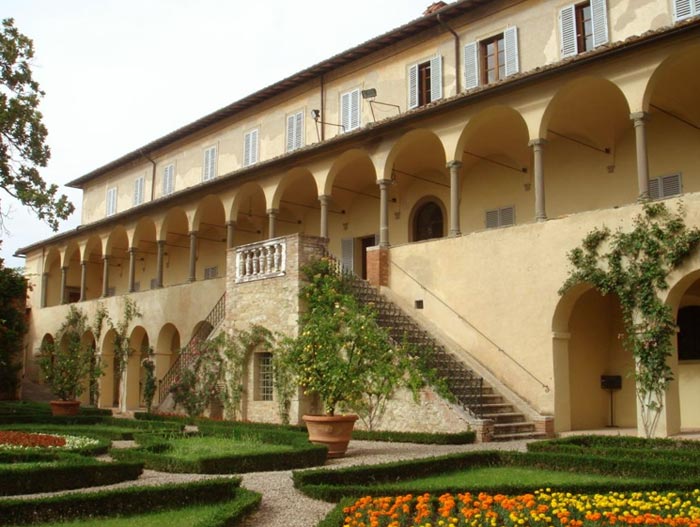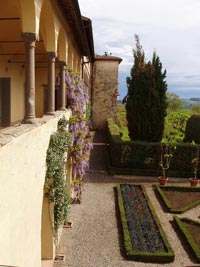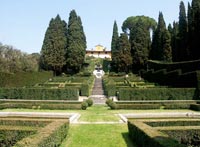Fiesole, Settignano and Certosa are just a few places just outside of Florence that merit a visit.
A day trip from Florence to Fiesole is a must for any visitor to this part of Tuscany in Italy. Fiesole can be reached by car or bus, and also on foot along narrow walled roads past numerous fine villas, including the Villa Medici at Fiesole. Aside from the sights of interest within and near Fiesole itself, on a sunny day the view over Florence is spectacularly beautiful. Fiesole is a city of Etruscan and Roman origins and it was destroyed in 90 BC and subsequently entirely reconstructed. During the Renaissance it became a popular holiday destination and prominent families built many villas, including: Albizi, Medici, Salviati, Rondinelli Vitelli and Medici. The Villa Medici at Fiesole is one of the oldest Renaissance residences with a garden and is also one of the best preserved, but at the same time one of the least well known. While most of the villas dating back to the same period, such as Cafaggiolo and Trebbio, stand at the centre of agricultural concerns, Villa Medici had no connections at all with farming life. The villa was built during the mid fifteenth century when Cosimo the Elder employed Michellozzo di Bartolommeo to design it for his second son Giovanni dei Medici. Intended to be a setting for intellectual life rather than a working Villa, Villa Medici was constructed to be a demonstration of aesthetic and ideological values.
The first settlements in this area date back at least to the Bronze Age (about 2000 BC), but the foundation of a city itself, surrounded by walls, dates from the Hellenistic age (end of IV – beginning of III century. A . C.).
It became a typical Roman city, ant there are still traces of it, and after the fall of the Roman Empire it was invaded by the Lombards (VI-VII sec. D. C).
Though small, Fiesole is rich in monuments of great artistic value. Among the oldest there are the remains of the Etruscan walls, testifying the historical origin of the town, and the Roman theater dating to the first century BC, where in summer suggestive performances are still offered.
Remarkable is also Piazza Mino da Fiesole with the Church of St. Maria Primerana. Interesting are the Museo Bandini with a large exhibition of sculptures, paintings of Tuscan school of the XIII XIV XV century and the Archaeological Museum. Its ground floor houses Etruscan and Roman statues, stelae, bronze (from Fiesole) while the upper floor houses exhibits not coming from Fiesole and a room with cups, glasses and weapons.
Nice to visit is the Basilica of St. Alexander built on a pre-existing pagan temple converted in the Christian Church in the VI century. The Church of St. Francis dating back to the fourteenth and fifteenth century contains great works and the Ethnographic Museum exhibits missionary objects of Etruscan, Chinese and Egyptian origins.
From the train station Santa Maria Novella in Florence you can easily reach Fiesole by bus. Alternatively you can reach the station to Fiesole-Caldine, part of the municipality of Fiesole, 5 km far from Florence with which however it is not well connected.
Map of the bus stop in Certosa
Florence | Transport
Settignano | Settignano is a picturesque frazione ranged on a hillside northeast of Florence, Italy, with spectacular views that have attracted American expatriates for generations. The little borgo of Settignano carries a familiar name for having produced three sculptors of the Florentine Renaissance, Desiderio da Settignano and the Gamberini brothers, better known as Bernardo Rossellino and Antonio Rossellino. The young Michelangelo lived with a sculptor and his wife in Settignano—in a farmhouse that is now the "Villa Michelangelo"— where his father owned a marble quarry. In 1511 another sculptor was born there, Bartolomeo Ammanati. The marble quarries of Settignano produced this series of sculptors.
Roman remains are to be found in the borgo which claims connections to Septimus Severus—in whose honor a statue was erected in the oldest square in the 16th century, destroyed in 1944— though habitation here long preceded the Roman emperor. Settignano was a secure resort for estivation for members of the Guelf faction of Florence. Giovanni Boccaccio and Niccolò Tommaseo both appreciated its freshness, among the vineyards and olive groves that are the preferred setting for even the most formal Italian gardens.
Mark Twain and his wife stayed at the Villa Viviani in Settignano from September 1892 to June 1893, and greatly enjoyed their visit. Twain was very productive there, writing 1,800 pages including a first draft of Pudd'nhead Wilson. He said the villa "afford[ed] the most charming view to be found on this planet."
In 1898, Gabriele d'Annunzio purchased the trecento Villa della Capponcina on the outskirts of Settignano, in order to be nearer to his lover Eleanora Duse, at the Villa Porziuncola. Near Settignano are the Villa Gamberaia, a 14th-century villa famous for its 18th-century terraced garden, and secluded Villa I Tatti, the villa of Bernard Berenson, now a center of art history studies run by Harvard University.
Gardens in Tuscany | Villa i Tatti in Settignano
The Certosa di Firenze or Certosa del Galluzzo was built in the fourteenth century by Niccolò Acciaioli, lord of Florence who belonged to a large and wealthy family of bankers, as a center for religious life and youth education.
Construction began in 1342 and continued for several centuries thanks to the monetary support of the Florentine nobility. The palace, named after Niccolò Acciaioli, was once his residence and now contains the Pinacoteca (painting and fine art gallery).
The grandiose convent complex is a unique museum with works of art by great masters who worked in Florence between the 14th and 18th centuries. Today, the entire convent can be visited: the cloisters and their courtyards, the monk's quarters, the chapel and the rich Pinacoteca. From the mid 1900s, the Benedictine monks - who do not adhere to the rules of closure - have resided here. The Pinacoteca contains remarkable artistic and historical pieces. Among these, five lunettes that portray scenes from the Passion of Christ, opera completed by Pontormo between 1523 and 1525, originally placed in the large cloister.
The monumental complex is situated on the summit of Monte Acuto also called "Monte Santo", a cone-shaped hill, located near the village of Galuzzo, south of Florence.
the impressive monastic complex, which appears as a small fortified city with the monk's quarters, the church and bell tower and the Palazzo Acciaioli. The scheme of the complex included 13 elements plus the guest quarters and is shown on the map.
The access to the monastery was reconstructed in the 16th century and consists of a ramp offering a beautiful view: on the right you can see the natural rock outcropping, from which the hill is formed and with which the convent was built.
Through a ramp with covered steps, you enter into the Pinacoteca of Palazzo Acciaiuoli that faces the church square. On the lower floor are four salons, which extend all the way up to and under the large square.
The Pinacoteca contains frescoes originally located in the large Cloister portraying episodes of the Passion of Christ, painted by Jacopo Pontormo.
Jacopo Carucci, called the "Pontormo" was born in Pontorme di Empoli in 1494 and moved to Florence in 1508. His teachers were Mariotto Albertinelli, Piero di Cosimo and Andrea del Sarto.
Between 1523 and 1525 he did the frescoes for the Certosa of Galluzzo, while the plague epidemic was ravaging through Florence.
The salons lead you directly to the square of the church.
On the longer walls in the square, half-columns in the Doric-Tuscan style were positioned on the perimeter wall.
The church was originally built in the 14th century, but was totally renovated in the 16th century, when the facade and the choir, where 17th century paintings and the remarkable carved and inlaid wooden choir stalls) were done.
From here you can enter the fifteenth-century Chapel of Santa Maria, restored in the neo-gothic style in the 19th century.
Note the two sculptures by Andrea Della Robbia high up on the walls. Cross the corridor, also called "colloquium of the monks" where the monks could talk on pre-established days and times, and you arrive in the large cloister. During the 15th century, the cloister was fully rebuilt. Its once abundant pictorial and decorative heritage is relatively reduce, due to neglect and repeated looting and theft.
The Certosa remained the property or the Cistercian Order up until October 1810 when, by order of Napoleon, one hundred and fifty French infantry were transferred there.
After the restoration of the Grand Duke of Tuscany (1819), the monks were able to re-enter the monastery and secure the relocation of the various pieces of art to their original place. The two rectangles, inside the cloister towards the gallery of the church, are used as a religious burial ground; the one on the right for the monks, the other for the converted brothers. The cistern, or well, in the middle of the lawn, was built in 1521 by Francesco Gabbriello. The fourth side of the cloister is occupied by the base wall of the church and the structures located parallel to it: the chapel of reliquaries, the sacristy, the chapter house, and the refectory. The monks' cloister is also called cloister of the cells because 18 cells are placed on three sides.
The cell structure is visible from the outside and from their roofs that rise above the gallery and courtyard. The entrance doors to the individual cells - surmounted with lunette-shaped frescoes- are marked with a letter from the alphabet.
Next to each door is a small opening through which food was passed.
Cistercian monks spent their entire lives inside this small world, leaving only to celebrate the daily and nightly liturgies and on holidays for meals shared in the refectory.
The areas available to the monks are the ground floor, the garden with the well, the laboratory and the woodshed; on the upper floor, at the same height as the ambulatory of the cloister three rooms beyond the entrance corridor, which served for eating, studying, and resting, che servivano per mangiare, studiare. Some personal effects of the monks are also conserved in these rooms.
The small monks' cloister and the cloister of the converted are also interesting. From the cloister of the converted you return to the square in front of the church and under the loggia are the rooms intended as guest quarters.
The three rooms which are part of this visit are designated Apartment of the Pope, in remembrance of the extended stay of Pope Pius VI who was forced to remain from June 1798 to March 1799 because he was prisoner to Napoleon, and Pope Pius VII, who stayed for two days on July 8-9, 1809.
It is not so much the artistic value of the rooms but rather their historical value that elicits interest. Almost everything you see in the furnishings recalls the presence of the two Popes.
Towards the exit of the square of the church there is a magnificent view that brings the spirituality of the monastery in close contact with the beauty of the landscape..
The pharmacy and the restrooms are located outside of the residential monastic complex. |





